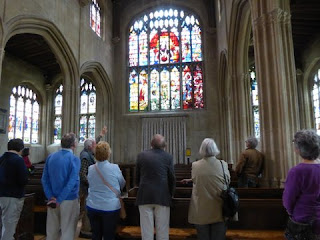The majority of us met at The Bull, and had lunch, and then went to look at the church.
The windows date back to the early 1500s, and no other parish church in the land has retained a complete set of medieval glass, and they're just down the road from us. They have been used to both express and teach by pictures the Christian faith for over 500 years; initially when the parishioners were illiterate, it must have been tremendous to have these windows as a backdrop to teaching the stories of the Bible.
We started with Eve, in the left hand light, seen here in an act of disobedience taking the fruit:
and on the right hand panel above the Burning Bush is depicted.
The second window depicts the Virgin Mary:
Below in greater detail you might be able to see a couple kissing, they are Mary's parents, Joachim and St Anne
The second light from the left depicts St Anne with Mary as a baby in her arms, but not easy to see here.
Below is a light in Window 6, where Christ rescues Adam and Eve from hell and proclaims the good news to imprisoned souls (The Harrowing of Hell)
Here in Window 25 below, we see the wicked priests with little lights above them in the clerestory windows revealing visions of exuberant horror.
And in Window 26 we have accursed rulers, with on the left a head in his hand, and on the right, Herod murdering an innocent babe.
And here are some of the group of around 24:
Looking up at the windows, binoculars are really useful, you can also use a zoom on a camera and look at the resulting image.
And finally looking at the magnificent Great West Window.
And then to tea and cakes in the lovely community centre. I would really recommend a visit with a guided tour, it makes all the difference.


















